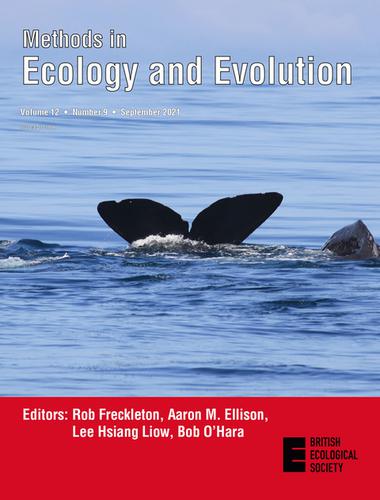当前位置:
X-MOL 学术
›
Methods Ecol. Evol.
›
论文详情
Our official English website, www.x-mol.net, welcomes your
feedback! (Note: you will need to create a separate account there.)
Cover Picture and Issue Information
Methods in Ecology and Evolution ( IF 6.3 ) Pub Date : 2021-09-01 , DOI: 10.1111/2041-210x.13417
Methods in Ecology and Evolution ( IF 6.3 ) Pub Date : 2021-09-01 , DOI: 10.1111/2041-210x.13417

|
This issue’s cover image shows three sperm whales (Physeter macrocephalus) beginning to dive in calm waters off the Galápagos Islands. As they descend, these whales will make Morse-code-like patterns of clicks, called codas, that convey their cultural identity. In their article, Hersh et al. present a new method that uses contaminated mixture models and hierarchical clustering to detect potential biological structure in acoustic datasets, such as sperm whale coda datasets. By looking for redundant, stereotyped, and distinct ‘identity calls’, the method was able to detect sperm whale cultures, wren subspecies, and cricket species. For taxa that readily vocalize but are cryptic or difficult to access, this method could help quantify behavioural diversity and population structure.
中文翻译:

封面图片和问题信息
本期封面图片显示,三头抹香鲸 ( Physeter macrocephalus ) 开始在加拉帕戈斯群岛附近的平静水域潜水。当它们下降时,这些鲸鱼会发出类似莫尔斯电码的点击模式,称为尾声,传达他们的文化身份。在他们的文章中,Hersh 等人。提出了一种新方法,该方法使用受污染的混合模型和层次聚类来检测声学数据集中的潜在生物结构,例如抹香鲸尾数据集。通过寻找多余的、刻板的和独特的“身份识别”,该方法能够检测抹香鲸文化、鹪鹩亚种和蟋蟀物种。对于容易发声但神秘或难以访问的分类群,这种方法可以帮助量化行为多样性和种群结构。
更新日期:2021-09-01
中文翻译:

封面图片和问题信息
本期封面图片显示,三头抹香鲸 ( Physeter macrocephalus ) 开始在加拉帕戈斯群岛附近的平静水域潜水。当它们下降时,这些鲸鱼会发出类似莫尔斯电码的点击模式,称为尾声,传达他们的文化身份。在他们的文章中,Hersh 等人。提出了一种新方法,该方法使用受污染的混合模型和层次聚类来检测声学数据集中的潜在生物结构,例如抹香鲸尾数据集。通过寻找多余的、刻板的和独特的“身份识别”,该方法能够检测抹香鲸文化、鹪鹩亚种和蟋蟀物种。对于容易发声但神秘或难以访问的分类群,这种方法可以帮助量化行为多样性和种群结构。











































 京公网安备 11010802027423号
京公网安备 11010802027423号